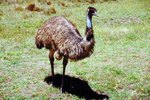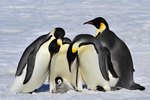
The penguin family consists of 17 different species, and no two species look exactly the same. If you pick up on noteworthy features in these diverse creatures, whether they relate to coloring or tail feathers, you might be able to accurately identify the species' of these sea birds. Observing eating habits can sometimes be revealing, too.
Size Differences
All penguins possess similar overall body outlines. They have sleek, extended physiques that decrease in thickness at the top and bottom portions of their bodies alike. Penguins also possess inconspicuous necks and sizable heads. Their bodies are designed for swimming success. While penguins' body shapes are similar, their sizes drastically differ. Emperor penguins (Aptenodytes forsteri) are the biggest of them all, sometimes weighing as much as 90 pounds. Little penguins (Eudyptula minor) are the opposite -- the tiniest. Mature little penguins usually weigh a little more than 2 pounds. King penguins (Aptenodytes patagonicus) usually weigh between 30 and 35 pounds. Gentoo penguins (Pygoscelis papua) typically weigh in the ballpark of 12 to 14 pounds.
Nuances in Color
Mature penguins, regardless of species, all have pale stomachs and darker backs. Certain color clues can give clues of a penguin's species. Both king and emperor penguins have black heads. They also both have bright coloration on the edges of their heads -- orange for the kings and yellow for the emperors. Yellow-eyed penguins (Megadyptes antipodes) indeed boast yellowish eyes. Little penguins often have deep grayish-blue bodies. Macaroni penguins (Eudyptes chrysolophus) have memorable yellow feathering on their heads. Paying attention to differences in color can go a long way in helping you pinpoint species of penguins.
Tail Observation
Tails on penguins are small and reminiscent of wedges, shapewise. If a penguin is part of the genus Pygoscelis, the feathers on his tail might be more extended. The living penguin species in this genus are gentoo penguins, chinstrap penguins (Pygoscelis antarcticus) and Adelie penguins (Pygoscelis adeliae). If a penguin's tail seems to have longer feathers than those of most others, he might fit into one of these categories -- specifically brush-tailed penguins.
Feeding Plans
Fish, krill and squid are dietary staples for penguins of all varieties. Taking note of exactly what penguins consume can sometimes be a handy indication of their specific geographic locations, however. Those living near Antarctica typically feed on higher amounts of krill and squid. Those in northerly settings generally dine more heavily on fish. Penguins who consume mostly fish also usually have noticeably more slender beaks.
References
Photo Credits
-
John Foxx/Stockbyte/Getty Images




